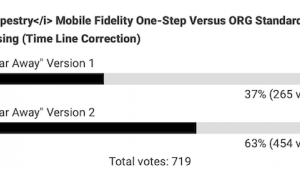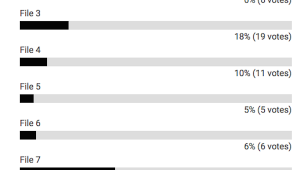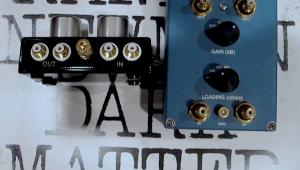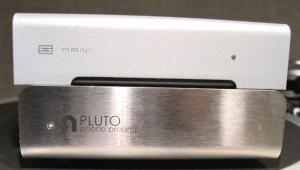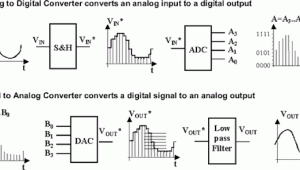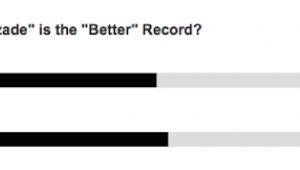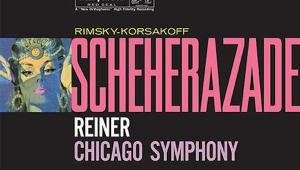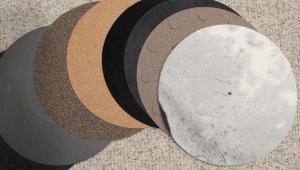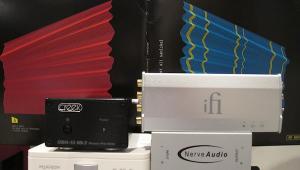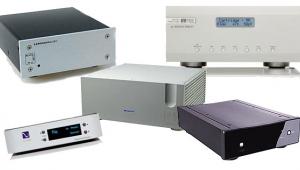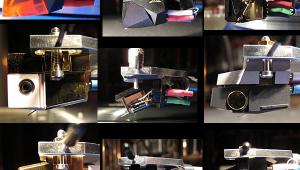Anybody know if this is the new AP reissue?
Primary tabs
VPI’s 3D "Printed" Tone Arm: Does it Sound Better, Worse, or the Same As the Standard Metal JMW Memorial Arm?

You make the call here. Here are two 96/24 files. Are they both the same file? Or, if you hear one sounding better, state your preference.
If the files are different, one file features the Lyra Atlas installed in the standard VPI JMW arm mounted on VPI's new Classic Direct Drive turntable.
The other file features the Lyra Atlas installed on the new 3D printed tone arm on the same turntable. All measured set-up parameters were identical.
The phono preamp is the Ypsilon VPS100. The preamp is the D'Agostino Momentum while the A/D converter is Ayre's QA-9. The interconnect between the phono pre and preamp is TARA Labs Evolution, which replaces the Zero.
Please vote and leave a comment explaining your vote.

- Log in or register to post comments

I agree that the sound is pretty spectacular, but even on your samples I could hear way too many snaps and ticks for a new record that many people are praising as near-perfect and dead quiet. Yours is considerably quieter than the copy I received though, which I had to return because it was unlistenable, with constant ticking and popping. Same for my copies of Sheherazade, the Respighi and the Gershwin. My replacement copy of Sheherazade (I passed on replacing the others) was only marginally better. Disappointing, especially after all the hype. Music like this, with so many quiet passages, demands a near-CD quiet surface, which QRP is capable of producing when they get it right.

Not sure which I would call "better". A has sharper highs than B. B sounds more like my current rig, which I keep feeling like there's a problem with my setup since high frequencies never seem as crisp as maybe they should be when comparing to other recordings for the same material (CDs, even MFSL UDCDs, other vinyl recordings). Whether my setup is better than theirs or not is still a subject of frustration for me. Is it simply that the sharper highs are distortion or over-emphasis of higher frequencies than is appropriate? No idea. That's the same issue that I have with these two samples. It's also reminiscent of what I've read people stating about the sound difference between silver and copper cables, with A being the brighter, silver-esque version. *shrug* So yeah, while I hear definite differences, I can't really state a preference. Something with vocals MIGHT help.
I also have to edit this in Audition to get them to start at the same point for ABX testing, as well as use ReplayGain to get the volume levels to more closely match. It might be helpful to boost the gain during recording to get the loudest sections to peak around -3dB. Obviously too high causes distortion, but too low seems to reduce impact. Since B already seems to have less impact, the fact that its input volume is so much lower than A makes me wonder if the recording levels are adding to the sound difference that might not be as pronounced with matching recording levels.
For the record, I'm using Foobar2000 for playback, using an iBasso D7 as a USB-to-SPDIF passthrough to a Benchmark DAC1, feeding some Lawton-modded Denon AH-D2000 headphones.
On a side note, why do I always have to use the Forgot Password here after I change it and log out in order to log back in with the new password? Very strange, and quite annoying.

Files aren't working, I get two seconds and it freezes..

To my ears on my computer without headphones, "B" seem to have more natural bloom in the cymbal crashes and more space around instruments.

I think they both sounded equally good. I voted for B because it sounded more like my present set up. Not knowing what exactly LIVE RECORDING had sounded it is difficult to say which one is better. It would depend upon you personal preferance and what you are used to.

B for me, played through my mid range hi-fi, or what's left of it as I didn't watch the volume properly  ... must be fun next door to Fremer's eh? Thanks for this tantalising glimpse of "high end" What's the LP??
... must be fun next door to Fremer's eh? Thanks for this tantalising glimpse of "high end" What's the LP??

I voted for “A” though I wouldn’t say it sounds “better.” I’d just say that I preferred it. “B” had more room echo on the drum thwacks that seemed to interfere with the next note of the music. “A” sounded more immediate to me. It’s like I was sitting nearer the orchestra surrounded by well fed Americans. “B” sounded to me like I was sitting further back in the hall behind a group of skinny Europeans.

I voted for A, but liked some things in B as well using an old Mac with audioquest dragonfly connected to Sennheiser 650s. I then played the cut on vinyl using my new Analogue Productions Pictures at an Exhibition release with a VPI Aires, JMW 10 inch arm, and Lyra Delos cart using Spectral phono preamp and tubed electronics (WA6 SE) through the Sennheiser and preferred the sound to that of either of the HiRezs choices, but not by a very wide margin! Interestingly, Choice B was closer to the vinyl sound on my setup than Choice A. Anyone else try a similar test?

Great idea for a comparison, but Track A is about 3 dB louder, so it's impossible to do a subjective assesment. If this is simply a tonearm comparison, with everything else identical, how does that even happen? Can a tonearm alone cause the level to be 3dB different? I don't think so.

No better way to show the superiority of analog over digital than in a simple comparison test using two digitized files. Some say 96kHz/24bit is more than enough to capture analog recordings, but if 192kHz/24bit sounds better than 96/24 and analog really sounds better than either of those, is it really a surprise that file "A" and "B", both digitized & compressed to a 96/24 resolution, have near equal followings with almost 1 in 5 saying the two recordings are identical? Maybe 96/24 really isn't enough to capture the differences between the two analog signals. At least it tells us something about the extent of the difference, but how much is it? Looking forward to Mr Fremer’s review to find out.

How can we a/b rapidly to hear marked differences
if the files are just different snips from the same song......
I'd like to hear them started at exactly the same point,
so I can swap back and forth on a given cymbal whack etc
Thanks

i hear the file number one as more dynamically open. the highs (cymbals in particular) are compressed as well as the lows on file two.

Very few people are mentioning that the tracks differ in level by at least 2 dB. That's quite a lot, and impossible to explain by a simple tonearm swap (I think), so I'd like to know more about how the files were created, and also how people are doing the level matching.
I would recommend at the very least that track A be played back 2 dB lower than track B, as that's the unweighted difference. However, if you look at peaks the difference is a little greater, and if you look at the LKFS loudness (I'm a TV commercial editor, so I have to do an LKFS measurement for all my mixes to make them broadcast-legal) it's close to a 3 dB difference.
Before voting, I'll do a more careful listening session with friends tonight and play around with level adjustments in the 2 to 3 dB range.

The epoxy construction of the 3D arm "impedes the transfer of vibration" (aka energy lost as heat), so, if true, a stronger electrical signal from the stylus ought to be one result. If the 3D arm works as advertised and all other parameters are kept constant (aka the comparison is "not "rigged""), we would expect the 3D arm to have an increased electrical output versus the normal arm, since more energy would be transferred electrically than physically lost as heat. If "A" is the 3D arm, the increased electrical output would support that hypothesis (and also be a good quantifiable measurement for future efforts). If not, bummer. I've never seen electrical output measurements by tonearm for a given cartridge, so 2dB may be a massive or tiny change. Has to drive reviewers crazy though... recognizing the difference in output by arm [by cartridge], than readjusting pre-amp output levels for a fair comparison of the different arm(s).

They definitely sound different. Really cool to get to hear these!
A is louder than B per Adobe Audition. A also has more detail than B per my review over headphones (using Decibel for playback on a MacBook Pro).
Assuming no change in the vinyl, and no errors otherwise, it is very interesting that changing only a tone arm could change the level of a recording!
If a tonearm has less resonance, then more of the energy may go to the motor in the cartridge. Maybe that explains the volume difference?
Voting for A as the recording from the new 3D-printed tonearm.
I look forward to learning which is which, even if my guess is wrong.
I use a VPI Classic with a Soundsmith Zephr these days, and have very much benefited from learning from Mr. Fremer's articles and DVDs.

I thought B sounded more relaxed, airy, and a tad more detailed than A. The recording space is more defined as well. However A had better mid-bass punch and actually sounded a little more balanced.
I am going to say B is the new 3D arm and A is the metal arm.

With no wrap on the arm.
I'm considering an upgrade from that to the 3D, and unfortunately I don't know how much of an improvement the Classic Signature arm with the wrap was over the regular Classic arm.

I won't vote for him, but he chose A and he said by a wide margin for his experience. I carried the files to school at 2496 in my Tascam DR-2D for him to listen to through my Sony 7506s. He is in his mid 30's and his hearing in intact.

We played the tracks back and forth about 8 times -- the first two times with no level matching, then with a concerted effort (and an spl meter) to get the levels the same. Level matching can be somewhat problematic in a case like this: Do you do a match in the midrange, use an unweighted SPL meter to match peaks, or do an analysis of the files and go by the LKFS measurement (perhaps even normalizing them digitally)?
Anyway, it was clear that File B was smoother, more relaxed and quiet in the background, while File A was more dynamic, extended and somewhat splashy. The vinyl-head among us strongly preferred File B, and several described it as "cleaner," even though File A had subjectively deeper bass and more high frequency detail. With the levels matched fairly closely, the differences remained.
If this is really a like-with-like comparision, I'm shocked that these two arms can display such a dramatic contrast, particularly in the levels. I heard a demo of the arms at the VPI factory last year when the 3-D arm was first announced, and they did not sound this dramatically different to me. I look forward to the big reveal of which is which.

On my setup, "A" was a little more rock n' roll and "B" a good bit smoother. But while I liked the slam of "A," it had a few harsh-ish moments that led me to prefer "B."
However, it's possible that we'd just get the slam without the harsh on Mikey's system (pre-digital conversion).

What has in principle always happened to me, when things are improving, is like going from 'A' to 'B'. I don´t experience the difference large, but certainly very noticeable. So for me, should there be any reason at all to choose an epoxy arm, it must then be 'B'

I would then love to copy them to a DVD-r and then replay them on my big rig without computer involvement altering the files?

Of course you can download the files... don't know what web browser you're using, but on mine (firefox), when I click the links, I get a popup window allowing me to either "open" the files, or save them to a hard drive location. You could also just right-click the links and select "Save Link As"... and then pick a folder to download them to.

I thought "A" sounded more natural; in particular the cymbals sounded the way I remember them sounding when I played percussion in band and orchestra in High School; by comparison "B" sounded a bit rolled off and missing in initial impact.
However depending on how the recording was miked, what sounds natural could be bright and the rolled-off sounding "B" could be right, but assuming proper miking, I like "A."


